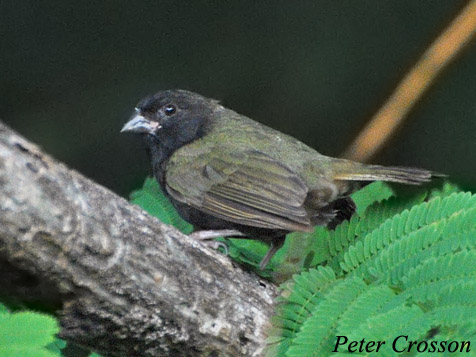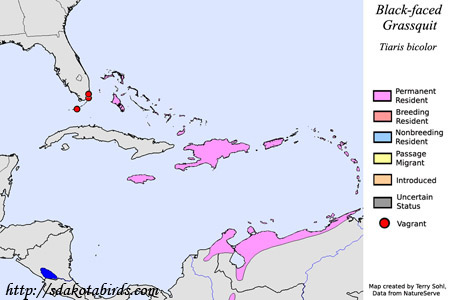| Length: 4.25 inches | Wingspan: 6.75 inches | Seasonality: Non-resident in South Dakota |
| ID Keys: Dull greenish back, black head and throat (male). Female brownish. | ||
 The
Black-faced Grassquit is primarily a bird of the Caribbean, found in Haiti,
the Dominican Republic, Puerto Rico, the Bahamas, and many other islands in
the region. They are also found as far south as the northern coast of
Venezuela. In the United States, they are known from occasionally
strays that show up in far southern Florida. They are common in many parts
of their range, and have adapted well to a human presence. They can
often be found in suburban settings, and will also come to bird feeders.
The
Black-faced Grassquit is primarily a bird of the Caribbean, found in Haiti,
the Dominican Republic, Puerto Rico, the Bahamas, and many other islands in
the region. They are also found as far south as the northern coast of
Venezuela. In the United States, they are known from occasionally
strays that show up in far southern Florida. They are common in many parts
of their range, and have adapted well to a human presence. They can
often be found in suburban settings, and will also come to bird feeders.
Habitat: Found in a variety of open habitats, including grassy fields, pastures, scrubland, agricultural lands, roadsides, forest edges and clearings, and suburban areas.
Diet: Feeds mostly on the grass seeds, but willl also sometimes take fruits and berries. Insects are also consumed, most often during the breeding season.
Behavior: Foraging is done on the ground or low in vegetation. Black-faced Grassquits will strip seeds directly from grassy heads, bending the grass stem down to gain access to the seeds at the top.
Nesting: The nest of a Black-faced Grassquit is a domed cup built of grasses and small twigs, lined with finer material such as fine grasses or animal hear. The nest is built close to the ground in a shrub or other low vegetation. The female lays between 2 and 4 eggs and she alone incubates them. Incubation takes about 12 days, and once the young hatch, both parents help to feed them.
Song: The male sings while doing a display flight for the female, with the song consisting of buzy zee-zee-zee phrases.
Migration: Considered a permanent resident throughout their normal range.
Feeders: Will readily attend feeders for millet and other offered seed items, feeding on the ground below feeders, or taking seeds directly from the feeder itself.
Interactive eBird map: Click here to access an interactive eBird map of Black-faced Grassquit sightings
Similar Species: Male plumage is distinctive if seen well.
Conservation Status: Populations of the Black-faced Grassquit are found over a wide geographic range, they are common in many areas, and populations overall appear to be increasing. The IUCN lists the Black-faced Grassquit as a species of "Least Concern".
Further Information: 1) Audubon Guide - Black-faced Grassquit
2) Cornell's NeoTropical Birds - Black-faced Grassquit
3) BirdLife International - Black-faced Grassquit
Photo Information: Photo by Peter Crosson - January 29th, 2013 - Costa Rica - Photo licensed under Creative Commons Attribution NonCommercial ShareAlike 2.0 Generic License
| Click below for a higher-resolution map |
 |
| South Dakota Status: Non-resident in South Dakota |
Additional Black-faced Grassquit Photos (coming soon!!)
